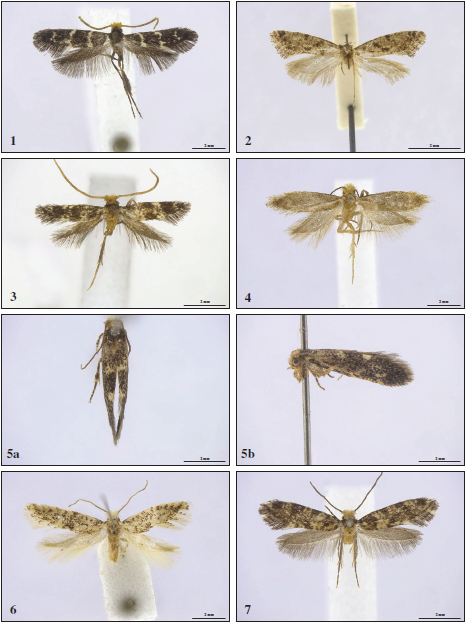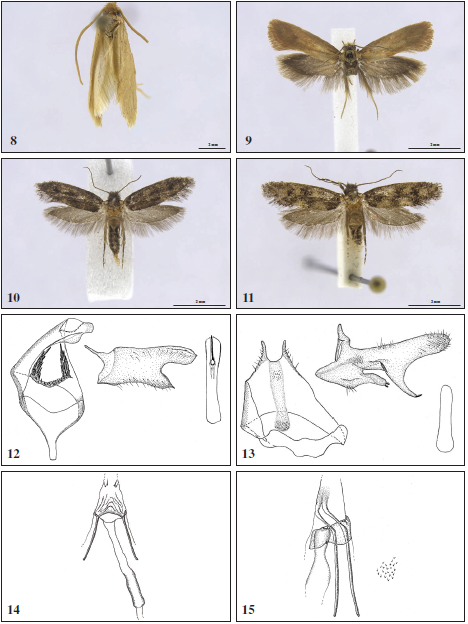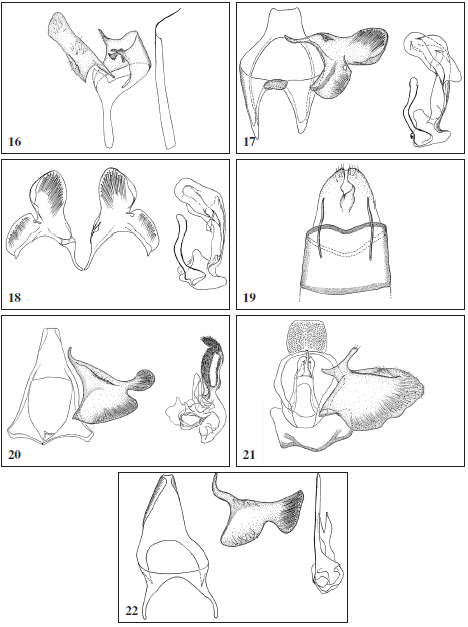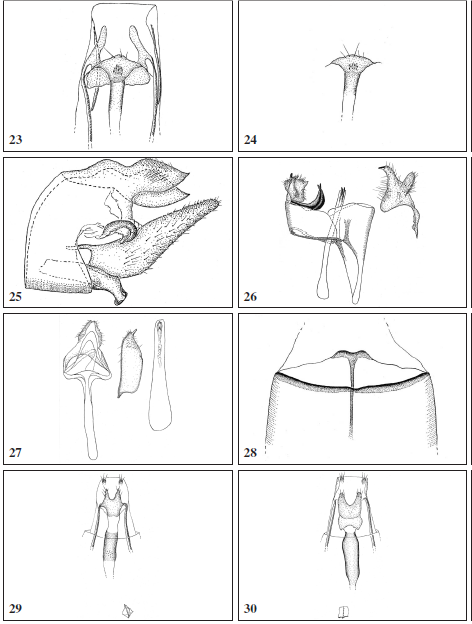

New West Palaearctic Meessiidae and Tineidae (Lepidoptera: Tineoidea)
Nuevos Meessiidae y Tineidae del Paleártico occidental (Lepidoptera: Tineoidea)
New West Palaearctic Meessiidae and Tineidae (Lepidoptera: Tineoidea)
SHILAP Revista de Lepidopterología, vol. 47, no. 185, 2019
Sociedad Hispano-Luso-Americana de Lepidopterología
Received: 08 June 2018
Accepted: 15 July 2018
Published: 30 March 2019
Abstract: Newly described and illustrated in the family Meessiidae are Eudarcia pulchra Gaedike, sp. n., Eudarcia dierli Gaedike, sp. n., Eudarcia creticola Gaedike, sp. n., Infurcitinea parincertula Gaedike, sp. n., Infurcitinea larseni Gaedike, sp. n., Infurcitinea rietzi Gaedike, sp. n. and Infurcitinea canaricola Gaedike, sp. n., and in the family Tineidae Perissomastix (Aphrodoxa)laricola Gaedike, sp. n., Anomalotinea hviidi Gaedike, sp. n., Elatobia maroccana Gaedike, sp. n. and Elatobia iberica Gaedike, sp. n.. The hitherto unknown female genitalia of Eudarcia forsteri (Petersen, 1964) (Meessiidae) and Nemapogon levantinus Petersen, 1961 (Tineidae) were described and illustrated for the first time.
Keywords: Lepidoptera, Tineoidea, Meessiidae, Tineidae, new species, West Palaearctic.
Resumen: Novedades descritas e ilustradas de la familia Meessiidae son Eudarcia pulchra Gaedike, sp. n., Eudarcia dierli Gaedike, sp. n., Eudarcia creticola Gaedike, sp. n., Infurcitinea parincertula Gaedike, sp. n., Infurcitinea larseni Gaedike, sp. n., Infurcitinea rietzi Gaedike, sp. n. y Infurcitinea canaricola Gaedike, sp. n., y en la familia Tineidae Perissomastix (Aphrodoxa) laricola Gaedike, sp. n., Anomalotinea hviidi Gaedike, sp. n., Elatobia maroccana Gaedike, sp. n. y Elatobia iberica Gaedike, sp. n.. Se describe e ilustra, por primera vez, la genitalia de la hembra de Eudarcia forsteri (Petersen, 1964) (Meessiidae) y Nemapogon levantinus Petersen, 1961 (Tineidae).
Palabras clave: Lepidoptera, Tineoidea, Meessiidae, Tineidae, nuevas especies, Paleártico occidental.
Introduction
Through the kindness of several colleagues it was possible in recent years to examine a rich material of the above-mentioned families. As a result, some previously undescribed taxa were detected, which are described below as new species. Additionally, the hitherto unknown females of two species were found.
REGIER et al. (2014), in reconstructing lepidopteran phylogeny based on 19 genes, found Eudarcia Clemens, 1860 to be the sister group to all remaining Ditrysia, and that it belongs to the Meessiidae, not to the Tineidae. The arrangement of the taxa below follows this opinion.
Abbreviations
coll. Baldizzone Giorgio Baldizzone, Asti, Italy
coll. Junnilainen Jari Junnilainen, Vantaa, Finland
coll. Kopp Andreas Kopp, Sirnach, Switzerland
coll. Roweck Hartmut Roweck, Kiel, Germany
coll. Werno Andreas Werno, Nunkirchen, Germany
SDEI Senckenberg Deutsches Entomologisches Institut, Müncheberg, Germany
ZMUC Zoological Museum, Copenhagen, Denmark
ZSM Zoologische Staatssammlung, Munich, Germany
MEESSIIDAE
Eudarcia pulchra Gaedike, sp. n. (Figs 1, 12)
Holotype: ♂, “BULGARIA, Kresna, 28-V-2006, J. Junnilainen leg.;” “Gen. präp. [genitalia slide] Gaedike 8215;” “Holotypus ♂, Eudarcia pulchra sp. n., det. R. Gaedike 2017;” coll. Junnilainen.
Description (Fig. 1): Wingspan 8mm; head brush golden-brown; labial palpus cream-coloured, short, second segment apically bristled; antenna nearly as long as forewing, ringed, scape creamcoloured; thorax and tegulae dark brown; forewing dark brown, with pattern of white thin stripes: first stripe at 1/4, from dorsum to costa, nearly straight, second stripe after 1/2, from beginning of fringe to costa, slightly bent to apex, in the mid interrupted, a third short stripe before apex from costa nearly to base of fringe, fringe overlaid with dark brown scales; hindwing dark brown.
Male genitalia (Fig. 12): Uncus with rounded tip, laterally each a semicircular lobe, vinculum with two lateral incisions, saccus short; subscaphium large, U-shaped, with numerous strong sclerotized spines; valva with narrow apodeme, costal edge more or less straight, apically rounded with minute tip, ventral edge more or less straight too, clearly shorter than costal edge, apically with thin, strongly sclerotized tooth, apical edge between costal and ventral apex roundly incised; phallus as long as ventral edge of valva, with one long, thin, strongly sclerotized cornutus.
Female genitalia: Unknown.
Etymology: Named after the colouration of adults.
Diagnosis: Superficially similar to the group of species, formerly placed in the genus Meessia, clear differences are seen in the structure of the genitalia: shape of uncus, subscaphium and valva.
Eudarcia dierli Gaedike, sp. n.(Figs 2, 13)
Holotype: ♂, “NEPAL, Prov. Nr. 2 East Jiri 2000 m, 2-IV-1964, leg. W. Dierl, Staatss[ammlun]g München;” “Gen. präp. [genitalia slide] Pet[ersen] 2188;” “Holotypus ♂, Eudarcia dierli sp. n., det. R. Gaedike 2017;” ZSM.
Description (Fig. 2): Wingspan 13mm; head nearly completely destroyed, antennae broken, head brush, so far visible, whitish; thorax and tegulae whitish; forewing whitish with a brown pattern: an oblique stripe from 1/4 below costa to beginning of fringe, a short stripe on costa apically 1/2, a short hook-like stripe before apex, shadow-like prolonged along termen; fringe with two brown lines; entire wing overlaid with scattered brown scales; hindwing white.
Male genitalia (Fig. 13): Uncus with two thin, more strongly sclerotized lobes, tegumen broad, vinculum band-shaped, without saccus, subscaphium longer than breadth of tegumen, apically rounded, with numerous minute thorns; valva longer than uncus-tegumen-saccus complex, nearly completely divided into a shorter ventral part, distally finger-like, with two short thorns and a much longer costal arm, apically rounded, ventral edge of costal arm prolonged to pointed tip with short thorn; apodeme with long thin process; phallus short, straight, without cornuti.
Female genitalia: Unknown.
Etymology: Named after the late Wolfgang Dierl, the collector of the type specimen.
Diagnosis: Superficially somewhat similar to E. orbiculodomus (Sakai & Saigusa, 1999), but much larger. Clear differences are in the genitalia structure: vinculum without saccus, valva divided into two parts, while orbiculodomus possesses a saccus, but the valva is undivided.
Eudarcia balcanicum (Gaedike, 1988)
The material, collected in BULGARIA: Blagojevgrad, Popori Livadi, 1415 m, 8-VIII-2013, leg. et coll. Kopp, contains the hitherto unknown female of this taxon (Fig. 14): Anterior apophysae apically forked, ventral arms very short, dorsal arms fused; last third of ductus bursae stronger sclerotized.
Eudarcia forsteri (Petersen, 1964)
The examination of still undetermined material, kindly sent to me by O. Karsholt, contains as well as a male one female, which was hitherto unknown (Fig. 15): Anterior apophysae apically somewhat enlarged; area around ostium band-like and strongly sclerotized, ostium and first half of ductus bursae strongly sclerotized, corpus bursae with numerous minute thorns.
Eudarcia creticola Gaedike, sp. n. (Figs 3,16)
Holotype: ♂, “GREECE, W-Crete, 10 km SW Omalos Plateau, N 35,3489 E 23,5154, 18-VI-2014, 760 m, [leg.] C. Hviid, O. Karsholt & F. Vilhelmsen;” “Coll. ZMUC Copenhagen Denmark;” “Gen. präp. [genitalia slide] Gaedike 9074;” “Holotypus 1, Eudarcia creticola sp. n., det. R. Gaedike 2017;” ZMUC; Paratype: 1 ♂ with same data, but genitalia slide Gaedike 9061; ZMUC.
Description (Fig. 3): Wingspan 7 mm; head brush light yellowish brown, from neck to insertion of antennae somewhat darker; labial palpus short, straight, second segment apically bristled; antenna longer than forewing, underside lighter than upperside; thorax and tegulae grey-brown; forewing dark brown, with whitish pattern: a stripe at 1/4 from costa to dorsum, partly overlaid with dark scales, at ½ a second stripe from costa to beginning of fringe, in the middle overlaid with dark scales, a small patch before apex on costa; the pattern of left and right forewing somewhat variable; fringe dark brown; hindwing grey-brown.
Male genitalia (Fig. 16): Uncus with two thin, strongly sclerotized lobes with pointed tips; subscaphium small, strongly sclerotized, with dentate inner edge, V-shaped; posterior margin of vinculum with deep lateral incisions, saccus long, with rounded tip; valva as long as vinculum +saccus, nearly parallel-sided, costal edge slightly concave, ventral edge slightly convex, basal third narrowly folded, apex rounded; phallus longer than uncus-tegumen-saccus complex, straight, the apical fourth needle-like.
Female genitalia: Unknown.
Etymology: Named after the place of collection of the type series.
Diagnosis: Superficially similar to the species of the glaseri-group, but the colouration of forewing more darker and the pattern is not so pronounced; clear differences are seen in the genitalia structure: valva without bristled area on inside, like glaseri, ignorata, saxatile, armatum, apical fourth of phallus needle-like.
Infurcitinea parincertula Gaedike, sp. n. (Figs 4, 17-19)
Holotype: ♂“MOROCCO, High Atlas, Ouirgane, 10 km NW, N 31º12’ 50”, W 8º4’ 24”, 30-V-3-VI-2015, 1050 m, [leg.] C. Hviid, O. Karsholt & K. Larsen;” “Coll. ZMUC Copenhagen Denmark;” “Gen. präp. [genitalia slide] Gaedike 8640;” “Holotypus ♂, Infurcitinea parincertula sp. n. det. R. Gaedike 2017;” ZMUC; Paratypes: 1 ♀, “MOROCCO, High Atlas, Ouirgane, 925 m, N 31º10’ 33”, W 8º 4’ 33”, 30-31-V-2015, [leg.] C. Hviid, O. Karsholt & K. Larsen;” “Coll. ZMUC Copenhagen Denmark;” “Gen. präp. [genitalia slide] Gaedike 8648;” ZMUC; 1 ♂, “ MOROCCO, High Atlas, Ouirgane, 820 m, 31º 10’ 43” N”, 8º 4’ 46” W”, 30-IV-5-V-2016, [leg.] C. Hviid, O. Karsholt & K. Larsen;” “Coll. ZMUC Copenhagen Denmark;” “Gen. präp. [genitalia slide] Gaedike 8981;” SDEI.
Description (Fig. 4): Wingspan 9-10 mm; head brush clay-coloured; labial palpus also claycoloured, outside with some darker scales, second segment apically bristled; antenna ringed; thorax and tegulae clay-coloured, basally with some darker scales; forewing unicoloured, without any pattern, completely overlaid with scattered darker scales; hindwing shiny whitish.
Male genitalia (Figs 17-18): Uncus truncated, vinculum laterally with two long processes with pointed tip; valva basally broad, with long apodeme, ventral part rounded, ending in a short thin process, directed upwards, the length is variable (see Fig. 18), costal arm two times longer than ventral part, costal edge concave, apex rounded, with more strongly sclerotized margin; phallus fused basally with anellus, slightly curved, with strongly sclerotized margins, subapically with two minute teeth, anellus twice as long as phallus, apical half broader, ending in two lobes, shape appears different,depending on preparation (see Fig. 18).
Female genitalia (Fig. 19): Segment VIII with stronger sclerotized basal and apical margin; ostium lip narrow, first part of ductus bursae enlarged, stronger sclerotized.
Etymology: Named because of similarity to I. incertula (Meyrick, 1928).
Diagnosis: Superficially not distinguishable from incertula, clear differences are seen in the genitalia structures: In the male uncus truncated, without lateral tips, while incertula has short lateral tips; valva with short thin process, while in incertula process nearly reaches costal edge; phallus with two minutes subapical teeth, while that of incertula is without teeth; and the shape of anellus is quite different. In the female apical margin of segment VIII more or less straight, while incertula has a clear emargination; ostium lip narrow, while incertula with deep U-shaped incision.
Infurcitinea larseni Gaedike, sp. n. (Figs 5a-5b, 20)
Holotype: ♂, “TURKEY, Gümüschane, Road to Siran, 14 km, 1300 m, 24-VII-1993, [leg.] K. Larsen;” “Gen. präp. [genitalia slide, together with the last thoracal segment with hindlegs and hindwings] Gaedike 7323;” “Holotypus ♂, Infurcitinea larseni sp. n. det. R. Gaedike 2017;” icoll. Roweck, SDEI.
Description (Figs 5a-5b): Wingspan 9/10 mm (specimen is not set); head brush cream-coloured; labial palpus cream-coloured too, last segment on outside with darker scales, second segment bristled; antenna dark grey; thorax and tegulae dark grey-brown; forewing groundcolour dark grey-brown with a pattern of whitish to cream-coloured dots and patches: each one small dot on costa at 1/2 and 3/4, one patch at 1/4 on dorsum, reaching cell, one round dot on dorsum at beginning of fringe; hindwing dark grey.
Male genitalia (Fig. 20): Uncus truncated, vinculum with lateral more or less triangular short processes, apically truncated; valva basally broad, ventral edge rounded, after 1/2 abruptly narrower, costal edge concave, costal arm with rounded bristled tip, from apodeme to narrowest part on inside a narrow row of bristles; phallus very small, fused with complexely shaped anellus, characteristic are two long processes, completely covered with short strongly sclerotized bristles.
Female genitalia: Unknown.
Etymology: Named after my friend Knud Larsen, the collector of the species.
Diagnosis: Superficially characterized by pattern of patches, while pattern in the hitherto known species of the genus with bands or stripes; the shape of phallus-anellus complex and shape of valva are distinguishing characters in genitalia structure.
Infurcitinea rietzi Gaedike, sp. n. (Figs 6, 21)
Holotype: ♂“SPANIEN, Alicante, Sierra Altana 1100 m, Font de Partegat, 23-VI-2013, [leg.] H. Rietz;” “Gen. präp. [genitalia slide] Gaedike 8290;” “Holotypus ♂, Infurcitinea rietzi sp. n. det. R. Gaedike 2017;” coll. C. Roweck.
Description (Fig. 6): Wingspan 9mm; head brush light cream-coloured, nearly white; labial palpus on inside cream-coloured, on outside brown, second segment bristled; scape of antenna creamcoloured, with pecten, flagellum ringed; thorax and tegulae cream-coloured, basally and apically with some dark brown scales; forewing cream-coloured, without any distinct pattern, entire wing with scattered dark brown scales, on dorsum, at beginning of fringe an indication of a dark brown patch, apical half of wing with more dark scales than basal half; hindwing white.
Male genitalia (Fig. 21): Uncus truncate, vinculum narrow, with two long lateral narrow processes, valva with long apodeme, costal edge concave, ventral edge rounded, at second half with round indentation, apex oblique, nearly as broad as base, bristled inside along apical margin; phallus fused with anellus, clearly longer than valva, basally bulbous, narrower to pointed tip, anellus 0.5 times of length of phallus, apically forked.
Female genitalia: Unknown.
Etymology: Named after H. Rietz, the collector of the species.
Diagnosis: The forewing without clear pattern is characteristic, in genitalia structure similar to I. sardiniella in the shape of valva, but without the upwards curved pointed tip of costal edge, clearly different too is the shape of phallus-anellus complex.
Infurcitinea canaricola Gaedike, sp. n. (Figs 7, 22)
Holotype: ♂, “ES (ESPAÑA), Tenerife, Arafo, e. l., 29-IV-2010, leg. J. Hilszczánski;” “larva 03-II-2010, in dead wood;” “ Gen. präp. [genitalia slide] Gaedike, remounted 2014 [from preparate T. Jaworski in vial];” “Holotypus ♂, Infurcitinea canaricola sp. n. det. R. Gaedike 2017;” SDEI.
Description (Fig. 7): Wingspan 7 mm; head brush pale yellowish; labial palpus short, straight, on inside shiny cream-coloured, on outside darker, second segment bristled; scape of antenna without pecten, pale yellowish, flagellum grey-brown; thorax and tegulae grey-brown; forewing also greybrown, with a pattern of pale cream-coloured patches and stripes, overlaid more or less with scattered dark scales: one stripe at 1/4 from costa to dorsum slightly curved to apex, at 1/2 and 3/4 on costa each a patch, reaching cell, one small dot on apex, one patch at dorsum at beginning of fringe; fringe overlaid with dark scales, forming a line along termen; hindwing grey.
Male genitalia (Fig. 22): Uncus truncated, covered with numerous minute thorns; tegumen narrow, band-shaped, vinculum twice as broad, without saccus; phallus small, fused with anellus, anellus with two narrow processes, connected with vinculum; valva broad, more or less oval, basally straight, apodeme short, with thin, basally bristled process, directed obliquely upwards, costal edge from base to rounded apex curved downwards, on inside along costal edge a rod-shaped sclerotization with a small bulge, ventral edge curved wave-shaped.
Female genitalia: Unknown.
Etymology: Named after the location of the type locality.
Diagnosis: Forewing with pattern of pale cream-coloured patches and stripes, overlaid with scattered dark scales distinguishes the new species from I. toechophila with clearly separated pattern on dark brown ground-colour; in male genitalia, the absence of saccus and the oval valva with curved downwards costal edge are differences, while I. toechophila has a saccus and the costal edge of valva clearly straight.
TINEIDAE
Nemapogon levantinus Petersen, 1961 A smaller series from: “GREECE, W-Crete, Omalos Plateau, 14-20-VI-2014, leg. C. Hviid; O.
Karsholt & F. Vilhelmsen” contains beside males the hitherto unknown females (Figs 23-24): Anterior apophysis ends in elongated narrow sclerotized plate, basally fused into a broad plate; ostium lip mushroom-shaped, apical edge with some bristles, inside with some short thorns; ductus bursae below ostium more strongly sclerotized than the other part, the sclerotization ends more or less abruptly; the shape of ostium lip somewhat variable: the apical edge more or less convex (see Fig. 27).
The genitalia structure is similar to the species of species group gravosaellus, especially arcosuensis and cyprica, but distinguishable from arcosuensis by the absence of strongly sclerotized ring below ostium and from cyprica by the basally fused anterior apophysae.
Perissomastix (Aphrodoxa) laricola Gaedike, sp. n. (Figs. 8,, 25)
Holotype: ♂, “IRAN, Fars, Lar, 30-III-4-IV-2009, [leg.] G. Petranyi;” “Gen. präp. [genitalia slide] Gaedike 7326;” “Holotypus ♂, Perissomastix (Aphrodoxa) laricola sp. n. det. R. Gaedike 2017;” coll. Roweck, SDEI.
Description (Fig. 8): Wingspan appr. 12 mm (specimen not set); head brush clay-coloured, basal part darker; labial palpus on inside pale yellowish, on outside with darker scales; antenna pale yellowish too; thorax and tegulae with same colouration, basally with some darker scales, forewing unicoloured shiny yellowish, without any pattern.
Male genitalia (Fig. 25): Uncus divided into two lobes, dorsal edge wave-shaped, with pointed tip; basally with a strongly sclerotized semicircular structure (praescaphium?); valva as long as uncustegumen- vinculum complex, from basal third narrower to rounded tip; phallus tube-shaped, dorsal edge before apex directed obliquely downwards, apex truncated.
Female genitalia: Unknown.
Etymology: Named after the locus typicus.
Diagnosis: Superficially not distinguishable from the other members of the subgenus, differences are seen in the genitalia structure: characteristic are the pointed tips of uncus lobes, while the lobes of the other taxa have a rounded tip, and the phallus a truncated apex.
Anomalotinea hviidi Gaedike, sp. n. (Figs 9, 26)
Holotype: ♂, “ MOROCCO, High Atlas, Ouirgane, 7 km S, N 31º 8’ 19”, W 8º 5’ 51”, 4-VI-2015, 950 m, [leg.] C. Hviid, O. Karsholt & K. Larsen;” “Coll. ZMUC Copenhagen Denmark;” “Gen. präp. [genitalia slide] Gaedike 8617;” “Holotypus ♂, Anomalotinea hviidi sp. n. det. R. Gaedike 2017;” ZMUC. Paratypus: 1 ♂, same dates, but “Gen. präp. [genitalia slide] Gaedike 8644;” ZMUC.
Description (Fig. 9): Wingspan 12-14 mm; head brush light brown; labial palpus on inside pale yellowish, on outside with darker scales, second segment bristled; scape of antenna with pecten, flagellum ringed; thorax and tegulae light brown, somewhat cinnamon coloured; forewing unicoloured brown, shiny cinnamon, without any pattern; hindwing grey.
Male genitalia (Fig. 26): Uncus apically truncated, laterally each with pointed tip; gnathos arms long, curved, narrower to the pointed tip; tegumen broad, basal edge more strongly sclerotized, vinculum as broad as tegumen, with long, more or less triangular saccus with rounded tip; valva with long apodeme, more or less triangular, apically ending in a strong sclerotized tooth, a finger-like bristled process at 1/3 protrudes from costal edge; phallus longer than vinculum-saccus, narrow, straight, with two thin strongly sclerotized cornuti.
Female genitalia: Unknown.
Etymology: Named after C. Hviid, one of the collectors of the type series.
Diagnosis: Superficially not with certainty distinguishable from the other members of the genus, but clear differences are visible in the genitalia structure: characteristic is the shape of valva with the apical tooth and the finger-like process.
Elatobia maroccana Gaedike, sp. n. (Figs 10, 27-29)
Holotype: ♂, “ MOROCCO, Marakech-Tensift-Haouz-Tamaloukt, n. [north of] Taroudant, 700 m, Lf [lux] 09-VIII-2013, leg. A. Werno;” “Gen. präp. [genitalia slide] Gaedike 9034;” “Holotypus ♂, Elatobia maroccana sp. n. det. R. Gaedike 2017;” coll. Werno.
Paratypes: 1 ♀, same data, but “Gen. präp. [genitalia slide] Gaedike 8096;” SDEI; 1 ♂, same location, but 10-VIII-2013; “Gen. präp. [genitalia slide] Gaedike 8095;” SDEI; 1 ♀, “ MOROCCO, Agadir, 21 km nördlich [north of] Hotel Panorama, Lf [lux] 08-VIII-2013, leg. A. Werno;” coll. Werno; 1 ♀, “ MOROCCO, Agadir, 21 km nördlich [north of] Hotel Tifrit, 635 m, Lf [lux] 06-VIII-2013, leg. A. Werno;” coll. Werno; 1 ♀, “ MOROCCO, Alto Atlante, Idni, 23-V-1986, leg. Curletti;” “Zool. Museum DK Copenhagen;” “Gen. präp. [genitalia slide] Gaedike 3630;” ZMUC.
Description (Fig. 10): Wingspan 10-11 mm (male), 11-13 mm (female); head brush nearly black, tips of scales whitish; labial palpus with same colouration, directed forward, second segment bristled, bristles with whitish tips; scape of antenna without pecten, flagellum ringed; thorax and tegulae with the same colouration as head brush, apical half of tegulae and tip of thorax cream-coloured; forewing nearly black, without any distinct pattern; around base, at mid-length along cell and at 1/2 on costa shadow-like darker; hindwing grey.
Male genitalia (Figs 27-28): Uncus shell-shaped, apically with short incision, vinculum narrow, band-shaped, saccus very long, straight, with rounded tip; inside the tegumen are two band-shaped structures (gnathos?); valva as long as uncus-tegumen, more or less parallel-sided, costal edge from short apodeme to apex more strongly sclerotized, ventral edge after 1/2 narrower to apex, apically with thin short tooth; phallus somewhat longer than saccus, basally rounded, straight, with two short, strongly sclerotized thorns on sclerotized field, vesica with minute thorns. Sternite VIII with strongly sclerotized posterior margin, tergite VIII medially with a T-shaped sclerotization (Fig. 30).
Female genitalia: (Fig. 29): Sternite VIII posteriorly with two pointed, bristled lobes, tergite VIII with two small bristled finger-like processes, ductus bursae below ostium with a longer strongly sclerotized area, inside with some minute thorns; signum small, more or less rhomboid-shaped, with keel-like fold.
Etymology: Named after the country [MAROCCO] in which the type series was collected.
Diagnosis: Superficially distinguishable from the other members of the genus by its broader forewings; in male genitalia uncus with short apical incision, valva apically with thin tooth, without longitudinal fold, phallus with two short cornuti, while fuliginosella and montelliella have uncus with two processes, valva with longitudinal fold, phallus with differently sized cornuti. In female genitalia the shape of sternite VIII is characteristic, while fuliginosella with plate-shaped sternite, montelliella with U-shaped emargination and rounded lobi and iberica (see below) with nearly ompletely strongly sclerotized ductus bursae.
Elatobia iberica Gaedike, sp. n. (Figs 11, 30)
Holotype: ♀, “HISP.[ANIA], Prov.[incia]. d.[e] Granada, 8 km al este de Baza, 11-VII-1987, leg. G. Baldizzone y E. Traugott-Olsen;” coll. Baldizzone.
Paratypes: 1 ♀, “HISP.[ANIA], Prov.[incia]. d.[e] Granada, Cam. Baza-Benamaurel, 15 km de aza, 16-VII-[19]87, leg. G. Baldizzone y E. Traugott-Olsen;” “Gen.präp. [genitalia slide] Petersen 3332;” coll. Baldizzone; 3 ♀♀, same location, but 17-VII-[19]87, 1 ♀with genitalia slide Gaedike 3280, 1 ♀ with genitalia slide Gaedike 3281; coll. Baldizzone; SDEI.
Description (Fig. 11): Wingspan 13-15mm; head brush nearly black, tips of scales whitish, scales on neck and below palpi cream-coloured; labial palpus directed forward, dark grey, third segment basally and apically cream-coloured, second segment bristled, bristles with whitish tip; scape of antenna dark grey, apically cream-coloured, flagellum ringed; thorax and tegulae cream-coloured mixed with dark grey, apically without dark scales; forewing cream-coloured with a dark brown pattern: dark brown are the base, a stripe from base along cell, directed obliquely to fringe at termen, and two patches above stripe at 1/2 and at 2/3. The borders of the lighter coloured parts are somewhat indistinct, the lighter parts partly overlaid with dark scales; hindwing grey.
Male genitalia: Unknown.
Female genitalia (Fig. 30): Sternite VIII posteriorly U-shaped, with two bristled lobes with rounded tips, tergite VIII with two small bristled finger-like processes, ostium band-shaped sclerotized, nearly the entire ductus bursae strongly sclerotized, signum small, square, basal margin more strongly sclerotized, in the middle with a row of minute thorns
.
Etymology: Named after the region in which the type series was collected.
Diagnosis: Superficially clearly distinguishable from the other members of the genus by having apattern on forewing.




Acknowledgements
I wish to thank all colleagues for their kindness in enabling me to examine their material. Special thanks to Tomasz Jaworski (Raszyn, Poland) for the permission to retain the holotype of I. canaricola in the collection of SDEI, to Christian Kutzscher (SDEI) for making the colour pictures and Andrew Liston (SDEI) for his linguistic corrections.
References
REGIER, J. C.; MITTER, C., DAVIS, D. R., HARRISON, T. L., SOHN, J-C., CUMMINGS, M. P., ZWICK, A. & MITTER, K. T., 2014.– A molecular phylogeny and revised classification for the oldest ditrysian moth lineages (Lepidoptera: Tineoidea), with implications for ancestral feeding habits of the mega-diverse Ditrysia.– Systematic Entomology, 39: 1-24, 11 figs.